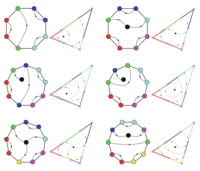Consistent Approximation of Local Flow Behavior for 2D Vector Fields using Edge Maps

|
Vector fields, represented as vector values sampled on the vertices of a triangulation, are commonly used to model physical phenomena. To analyze and understand vector fields, practitioners use derived properties such as the paths of massless particles advected by the flow, called streamlines. However, currently available numerical methods for computing streamlines do not guarantee preservation of fundamental invariants such as the fact that streamlines cannot cross. The resulting inconsistencies can cause errors in the analysis, e.g., invalid topological skeletons, and thus lead to misinterpretations of the data. We propose an alternate representation for triangulated vector fields that exchanges vector values with an encoding of the transversal flow behavior of each triangle. We call this representation edge maps. This work focuses on the mathematical properties of edge maps; a companion paper discusses some of their applications[1]. Edge maps allow for a multi-resolution approximation of flow by merging adjacent streamlines into an interval based mapping. Consistency is enforced at any resolution if the merged sets maintain an order-preserving property. At the coarsest resolution, we define a notion of equivalency between edge maps, and show that there exist 23 equivalence classes describing all possible behaviors of piecewise linear flow within a triangle. |
[DOI/EE link]
@incollection{JBBLNP11,
author = {Shreeraj Jadhav and Harsh Bhatia and Peer-Timo Bremer and Joshua A. Levine and Luis Gustavo Nonato and Valerio Pascucci},
booktitle = {Topological Methods in Data Analysis and Visualization II -- Theory, Algorithms, and Applications},
editor = {R. Peikert and H. Hauser and H. Carr and R. Fuchs},
ee = {http://dx.doi.org/10.1007/978-3-642-23175-9_10},
month = {1},
pages = {141--160},
publisher = {Springer},
title = {Consistent Approximation of Local Flow Behavior for {2D} Vector Fields using Edge Maps},
year = {2012}
}